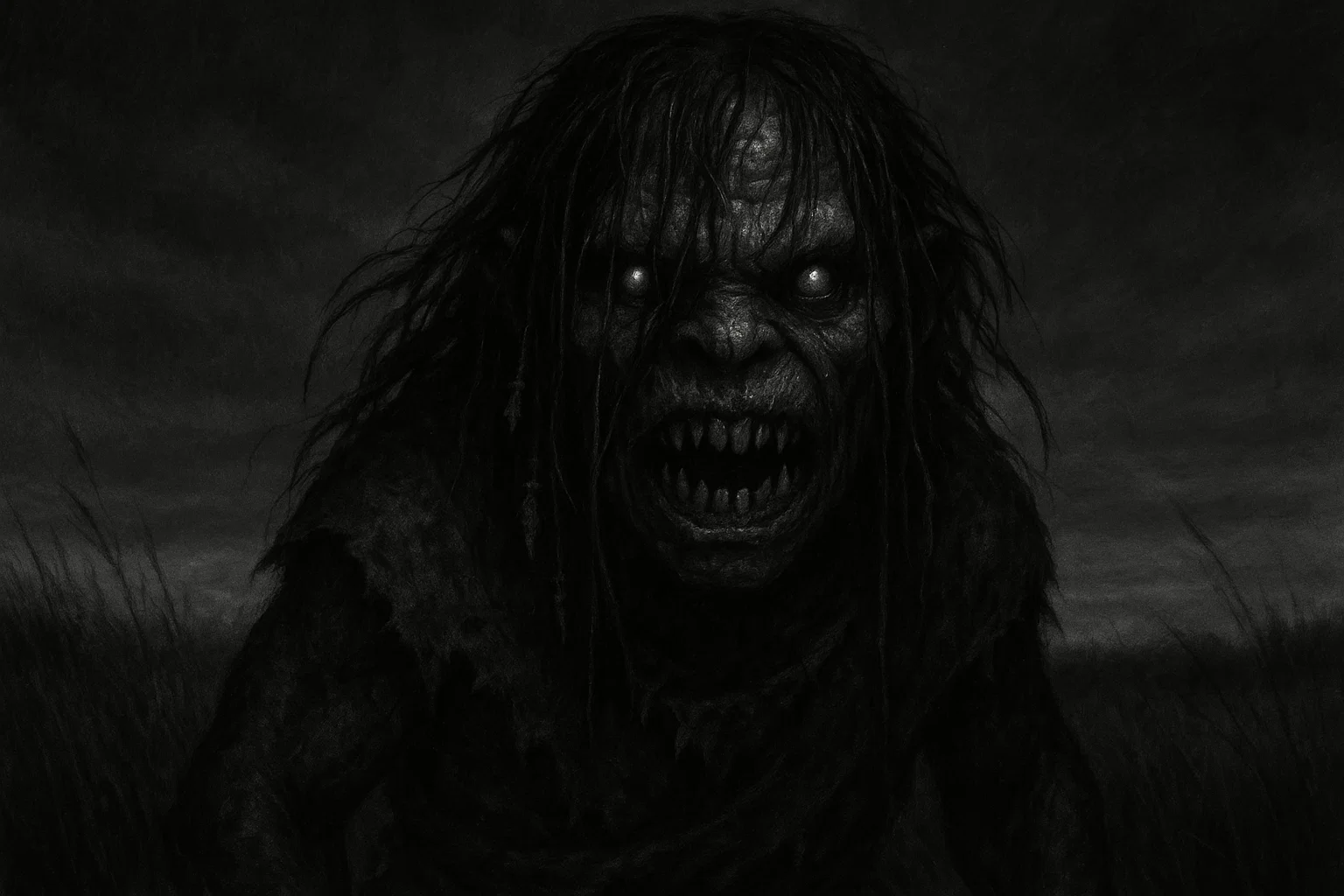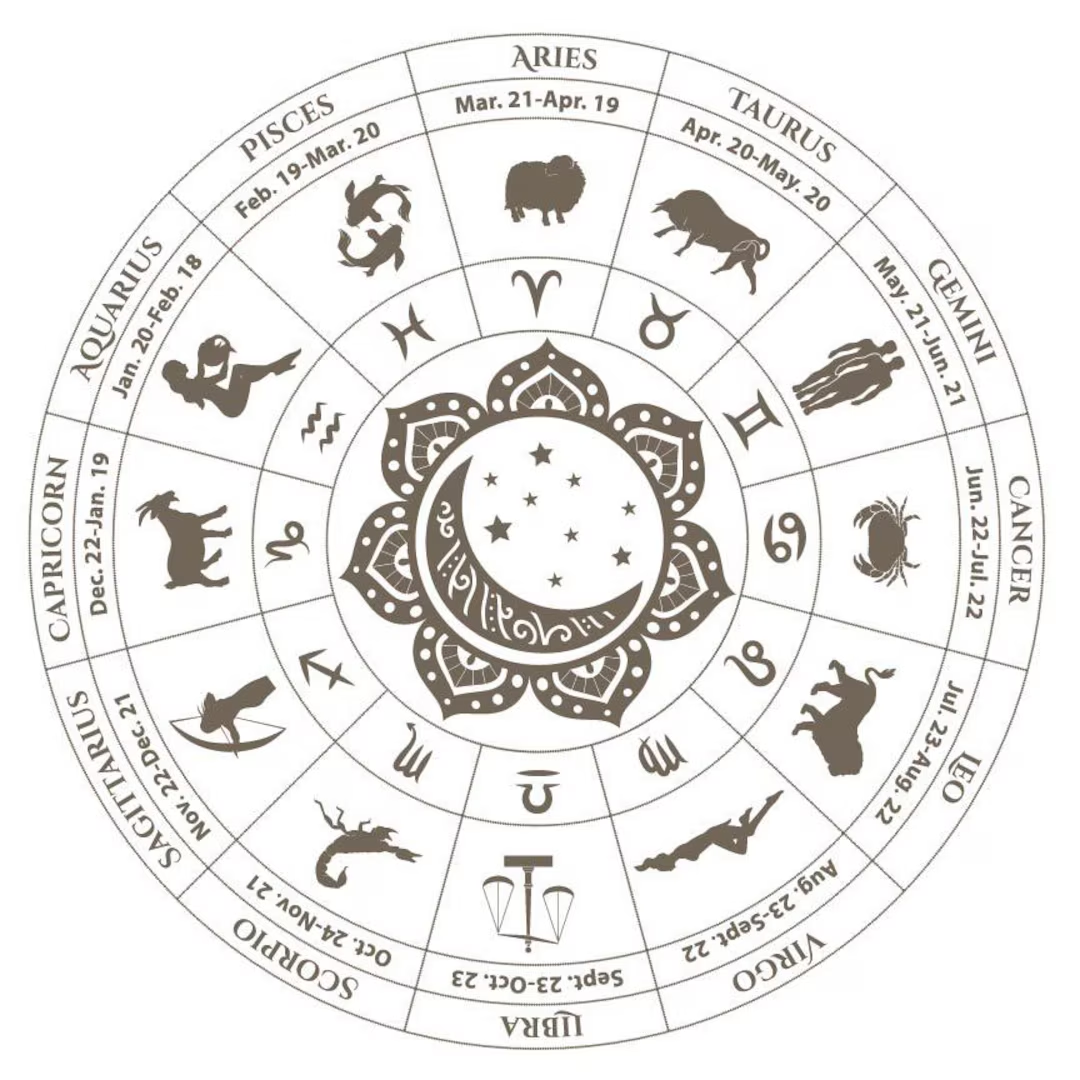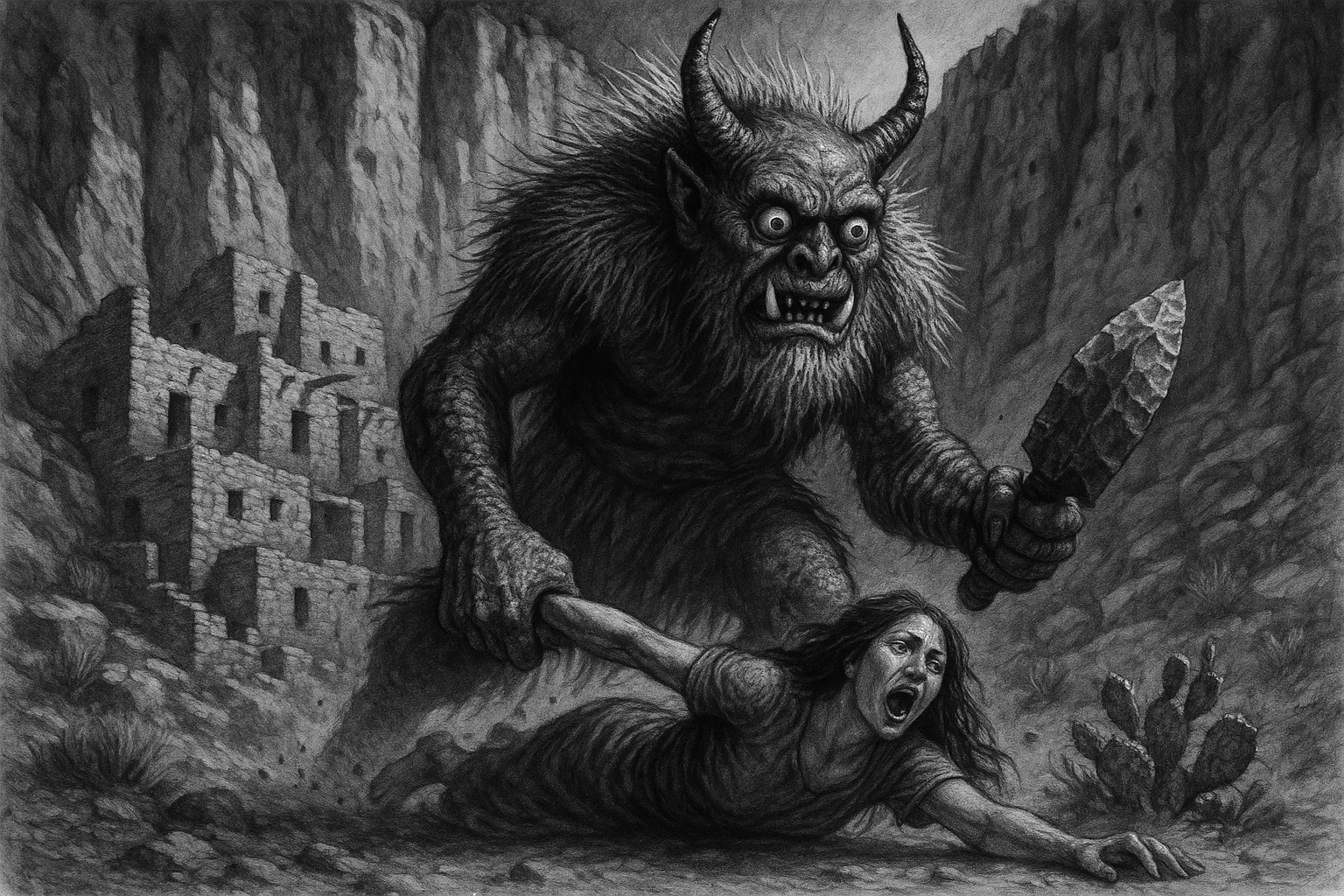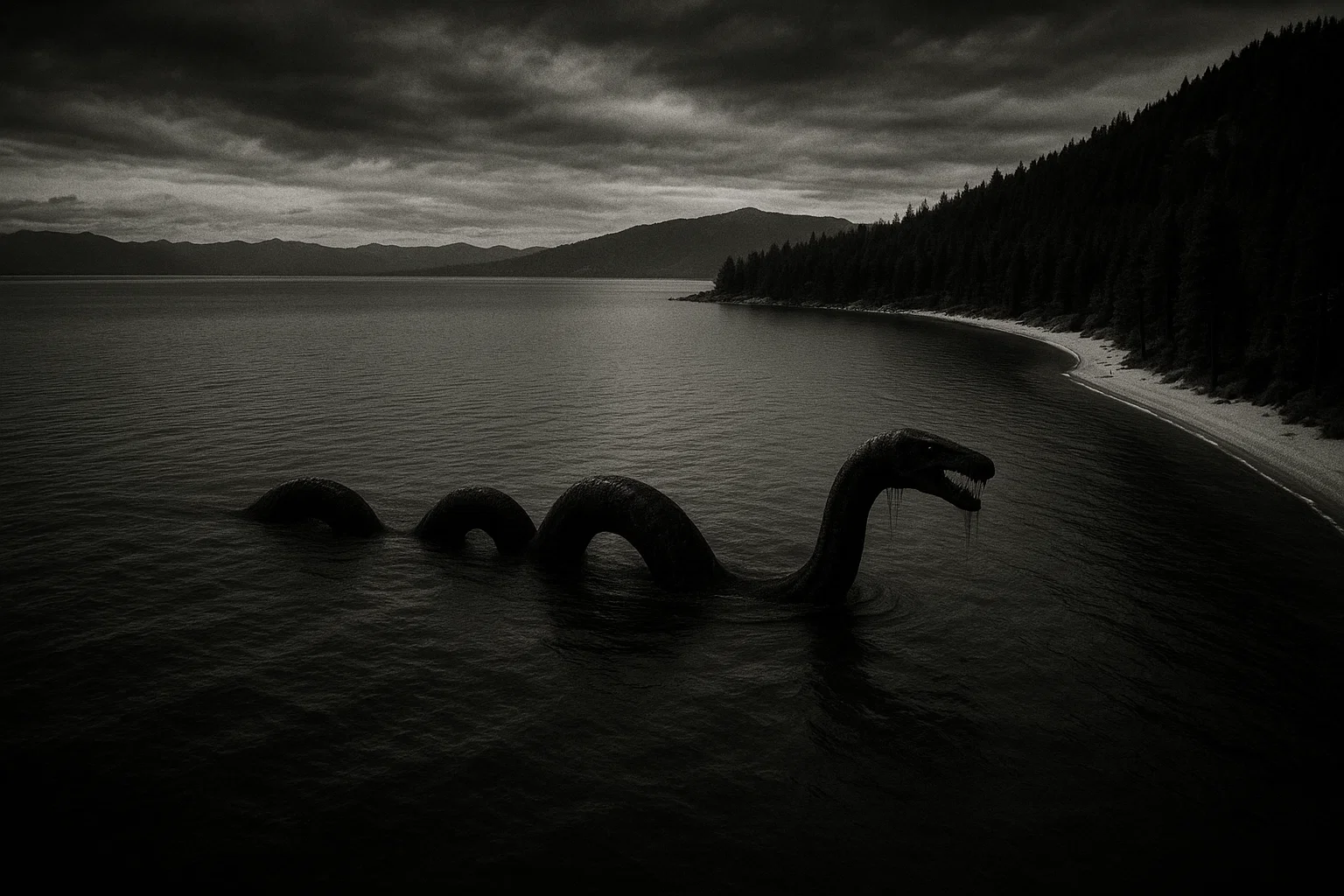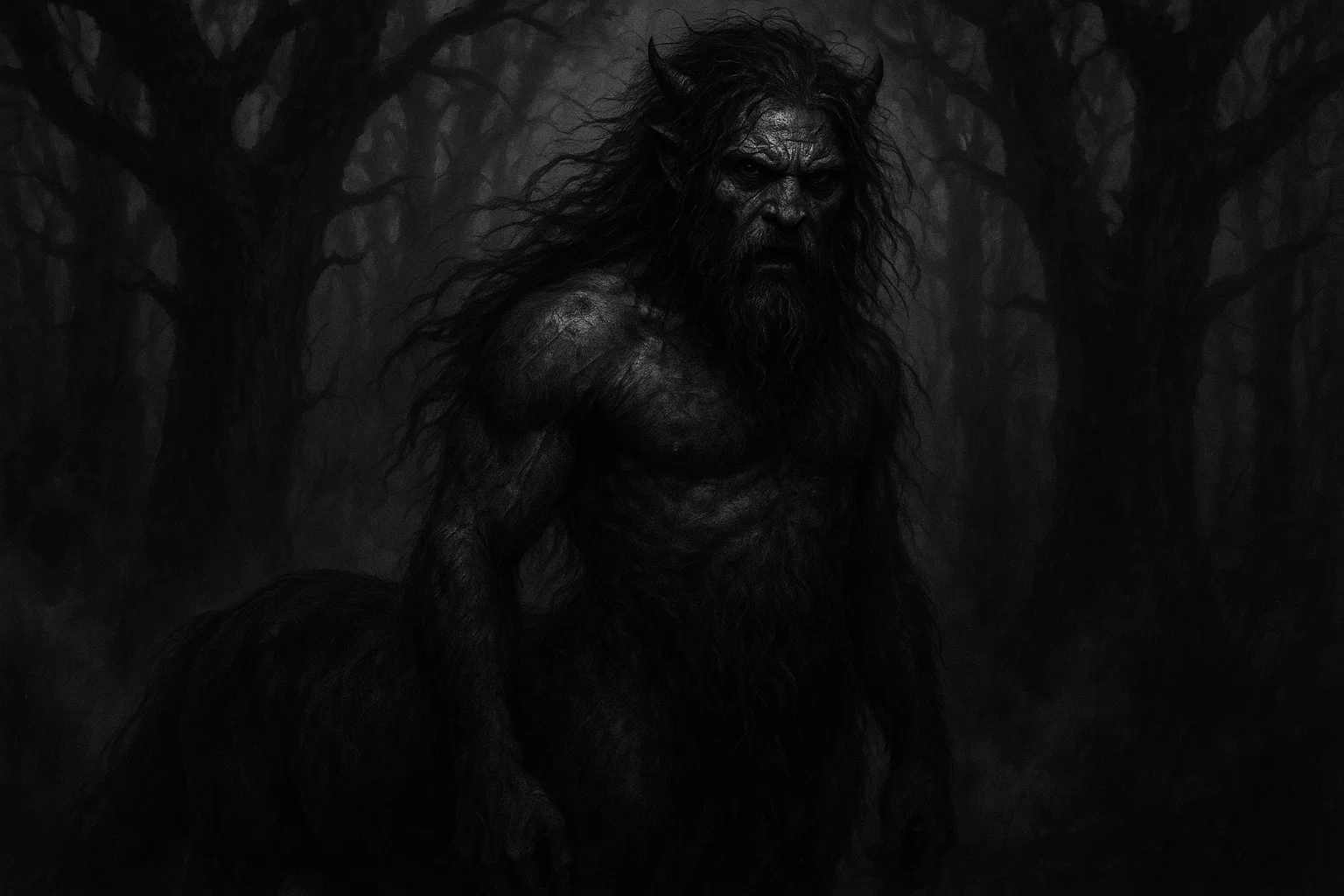The Teihiihan are strange cryptids from Native American folklore, particularly among Plains tribes such as the Arapaho and Cheyenne. These child-sized humanoids are known for their extreme aggression and cannibalistic habits.
Legends describe them as enemies of human tribes, capable of overpowering adults despite their small stature. The name Teihiihan derives from the Arapaho word for “strong,” reflecting their reputed superhuman power.
Stories of the Teihiihan emphasize their role as bloodthirsty warriors who attacked in groups. They are said to have inhabited the Great Plains region, where they preyed on travelers and hunters.
Traditional accounts often conclude with their defeat in ancient battles led by allied tribes. However, some narratives suggest remnants persist, explaining unexplained deaths or disappearances.
Summary
Overview
| Attribute | Details |
|---|---|
| Name | Teihiihan |
| Aliases | Cannibal Dwarves, Enemy Dwarves, Hecesiiteihii (Little People) |
| Threat Level | Predatory; highly aggressive toward humans, known for unprovoked attacks and cannibalism |
| Habitat | Great Plains region, including Wyoming, Colorado, and areas between the Rocky Mountains and Mississippi River; open grasslands and river valleys |
| Physical Traits | Child-sized (2-4 feet tall), dark skin, thick and tough hide, superhuman strength disproportionate to size; some reports note long hair or ragged clothing |
| Reported Sightings | Wyoming plains, Colorado foothills, Nebraska river areas; no specific modern cities, but tied to historical tribal territories |
| First Documented Sighting | Pre-colonial oral traditions; earliest recorded in 19th-century ethnographies of Arapaho and Cheyenne tribes |
| Species Classification | Humanoid; speculative classification as a degenerate hominid or faerie-like entity |
| Type | Terrestrial; ground-dwelling predators adapted to plains environments |
| Behavior & Traits | Nocturnal hunters, attack in packs, gluttonous cannibals who kill excess prey; believed to remove and hide their hearts for protection; warlike due to afterlife requirements |
| Evidence | Oral legends and tribal testimonies; no physical specimens, footprints, or photographs; some archaeological interpretations of small human remains |
| Possible Explanations | Misidentified encounters with feral humans or pygmy-like populations; cultural metaphors for warfare or famine-induced cannibalism |
| Status | Ongoing mystery in folklore; considered extinct in legends but blamed for modern unsolved incidents |
Who or What Is a Teihiihan?
The Teihiihan represent a race of small, ferocious beings in the oral traditions of several Plains Indian tribes, including the Arapaho, Cheyenne, Crow, and Gros Ventre.
Known primarily as cannibal dwarves, they are depicted as eternal enemies of humankind, driven by an insatiable hunger for flesh and a compulsion for violence. Unlike benevolent little people in other Native American stories, the Teihiihan embody malice and strength, often ambushing lone travelers or raiding camps at night.
In Arapaho lore, the Teihiihan—meaning “strong ones”—are child-sized warriors who believed death in battle was necessary for entry to their afterlife, fueling their relentless aggression. They lived in hidden villages on the plains, emerging to hunt humans with coordinated attacks.
Legends stress their gluttony, as they slaughtered more victims than they could consume. Allied tribes eventually waged war against them, using clever tactics to target their vulnerable hearts, which the dwarves removed and stored at home during hunts. This central myth highlights themes of survival and cunning in Plains cultures.
Your Personalized, Hyper Accurate Moon & Astrology Reading
Limited time offer: Get your FREE, fully personalized Moon & Astrology Reading that takes astrology to a whole new level. Discover the secret depths of your personality, relationships, and true purpose in life.
What Does the Teihiihan Look Like?
The Teihiihan are consistently described in tribal legends as diminutive humanoids, standing no taller than a human child—typically between 2 and 4 feet tall. Their bodies are stocky and muscular, with broad shoulders and thick limbs that belie their deceptive size.
Dark skin covers their forms, often a deep brown or reddish hue, providing camouflage on the dusty plains. Thick, tough hides make them resistant to arrows and clubs, allowing them to charge through defenses unscathed.
Facial features emphasize their menacing nature: wide mouths filled with sharp teeth suited for tearing flesh, small beady eyes that gleam in low light, and flattened noses. Hair is long and unkempt, sometimes matted with blood or braided with bones from past kills.
They wear rudimentary clothing pieced from animal hides or stolen human garments, ragged and stained from their nomadic hunts. Hands end in claw-like nails, used for grappling prey during ambushes.
Variations appear across tribes. Arapaho accounts highlight their speed, suggesting elongated legs or wiry builds for rapid sprints across grasslands.
Cheyenne stories add invisibility, perhaps through dust clouds or swift movements that blur their outlines. Some Gros Ventre tales describe them as hairless in patches, exposing scarred skin from ritual scarification. No reports mention tails or extra limbs, keeping them firmly humanoid.
You May Also Like: 10 Scary Campfire Stories That’ll Keep Everyone Awake All Night
Habitat
The Teihiihan are tied to the expansive Great Plains, a vast grassland ecosystem stretching from the Mississippi River in the east to the Rocky Mountains in the west. This region, encompassing modern-day Wyoming, Colorado, Nebraska, and parts of Kansas and Montana, provided ideal cover for their secretive raids.
Legends place their dwellings in low-lying river valleys and coulees—narrow gullies carved by streams—where cottonwood groves and scrub brush offered concealment. These areas, such as the Powder River Basin in Wyoming or the South Platte River valley in Colorado, feature flat terrain interrupted by shallow depressions that are perfect for ambushes.
Environmental details highlight the plains’ harsh, open nature: semi-arid climate with hot summers reaching 100°F and bitter winters dropping to -20°F, fostering a nomadic lifestyle for both tribes and Teihiihan.
Precipitation averages 15-20 inches annually, mostly as spring rains that turn grasslands into seas of buffalo grass and bluestem, where the dwarves could stalk prey unseen.
Fauna included bison herds numbering in the millions pre-contact, pronghorn antelope, and prairie dogs—potential food sources for the Teihiihan, though humans remained their preferred prey. Predators like coyotes and wolves competed in this chain, but the Teihiihan’s ferocity made them apex predators.
Teihiihan Sightings
| Date | Place | Witness Details | Description | Reliability |
|---|---|---|---|---|
| Pre-1800 (Oral Tradition) | Wyoming Plains, near Powder River | Arapaho hunters, unnamed elders | Group of child-sized figures ambushed hunting party, overpowered two men with clubs, dragged bodies away; survivors noted dark skin and swift retreat | Medium: Consistent oral accounts across generations, no physical corroboration |
| Early 1800s | Colorado Foothills, South Platte Valley | Cheyenne warriors during migration | Pack of dwarves attacked camp at night, killed livestock and one scout; described as strong enough to lift tipi poles, hearts removed from some bodies | Medium: Tribal migration logs reference event, multiple witnesses |
| Mid-1800s | Nebraska, Niobrara River area | Gros Ventre scouting party | Small humanoids with long hair charged from grass, bit and clawed victims; one captured and interrogated revealed heart-storing habit | Low: Single storyteller’s account in ethnography, potential embellishment |
| Late 1800s | Montana, Tongue River Valley | Crow tribe members during buffalo hunt | Dwarves stole children from edge of camp, left bloody tracks; rescuers found remains with bite marks | Medium: Corroborated by multiple families, aligns with regional lore |
| Early 1900s | Wyoming, Bighorn Basin | Arapaho ranch hands post-contact | Figures seen dragging calf carcass; one shot at but missed due to speed; dark forms vanished into coulee | Low: Anecdotal report in settler journals, possible cultural bias |
| Mid-1900s | Colorado, near Denver outskirts | Unnamed hikers in rural areas | Small aggressive beings hurled rocks, fled when approached; estimated 3 feet tall with ragged clothes | Low: Isolated modern claim, lacks tribal verification |
Arapaho Hunters Ambushed (Wyoming Plains, Pre-1800)
In traditional Arapaho narratives passed down through generations, a hunting party ventured onto the Wyoming plains near the Powder River during a dry summer season.
The group, consisting of five skilled warriors, spotted bison tracks leading into a grassy coulee. As they dismounted to stalk the herd, shadows stirred in the tall bluestem. Suddenly, a dozen Teihiihan erupted from hiding, their small forms a blur of motion.
Eyewitness accounts from survivors describe the dwarves leaping with unnatural force, tackling the largest hunter to the ground. One Teihiihan, no taller than a boy, pinned a 200-pound man’s arms while another bit into his throat, severing arteries in seconds.
The attackers wielded crude stone clubs and bone knives, shattering ribs and severing tendons. Two men fell immediately, their bodies hoisted effortlessly onto the dwarves’ shoulders despite the weight. The remaining three fired arrows, but the Teihiihan’s thick hides deflected most, and their speed allowed evasion into the grass.
One survivor, grazed by a claw, reported the creatures’ guttural chants—war cries invoking battle spirits. The party retreated to camp, where elders identified the assailants as Teihiihan based on the savage overkill: victims mutilated beyond mere sustenance.
Awaken XT is unlike anything you’ve ever tried before…
…it’s based off a closely guarded formula that’s said to be able to supercharge your pineal gland and help you access your untapped inner power. With it’s unique blend of extremely hard to source ingredients, Awaken XT helps support the healthy functioning of your pineal gland, as well as your other organs in your body.
Cheyenne Camp Raid (Colorado Foothills, Early 1800s)
During a Cheyenne migration along the South Platte Valley in the early 1800s, a night raid disrupted a family encampment under a full moon. The Warriors had secured the site with trip lines and guards, but the Teihiihan breached the defenses silently.
Accounts from three survivors detail how the dwarves, emerging from riverbank brush, targeted the outskirts first. A young scout patrolling the herd awoke to a Teihiihan gnawing on a horse’s flank, its jaws unhinging like a snake’s to tear chunks free.
Chaos ensued as 15-20 figures swarmed, their dark skins blending with shadows. One woman described a dwarf scaling her tipi, ripping through hides to drag her child out; the boy screamed as tiny hands clamped his mouth.
Warriors rallied, spearing two attackers, but the Teihiihan retaliated by ganging on a defender, overwhelming him with bites to limbs until bones cracked. Their strength shone when a pair lifted a fallen warrior’s body, vanishing into the night with it slung between them like a trophy.
The raid claimed one life and several animals, with bloodied grass marking the frenzy. Elders noted the absence of tracks leading away, attributing it to the creatures’ speed.
You May Also Like: Bigfoot Sightings Across America: Full 50-State Guide
Gros Ventre Captive’s Tale (Nebraska, Mid-1800s)
A Gros Ventre scouting party along the Niobrara River in mid-19th-century Nebraska was ambushed by Teihiihan while tracking elk.
Four men pursued signs into a willow thicket, where the ground gave way to hidden pits lined with stakes. Two tumbled in, impaled and dragged below by waiting dwarves. The leader, escaping with wounds, later shared his ordeal: captured alive, he was bound in a subterranean lodge reeking of decay.
Inside, walls hung with shriveled hearts— the Teihiihan’s external organs, pulsing faintly. His dim-witted captor boasted of the hunt, explaining how removing hearts granted invulnerability.
Seizing the moment, the scout feigned interest, then lunged, piercing hearts with a hidden knife shard. Distant screams echoed as kin dropped dead mid-raid elsewhere. The lodge emptied of life, allowing escape.
Crow Child Abduction (Montana, Late 1800s)
Near the Tongue River Valley in the late 1800s, Montana, a Crow buffalo hunt turned tragic when Teihiihan abducted children from a peripheral play area.
Multiple families recounted how dusk fell, and small forms slunk from sagebrush, snatching two siblings mid-game. A pursuing father speared one abductor, revealing its child-like frame but adult ferocity—claws raking his thigh deeply.
Rescuers tracked blood to a ravine den, finding one child alive, the other partially consumed amid bone piles. The dwarves fled en masse, their howls fading into the wind.
Evidence & Investigations
Evidence for the Teihiihan remains confined to oral histories and ethnographic records, with no tangible artifacts such as bones or tools. Tribal elders provided consistent testimony in the late 19th and early 20th centuries, as documented by anthropologists such as George Bird Grinnell in his 1923 work, The Cheyenne Indians.
These accounts detail ambushes and heart-removal rituals, cross-verified across Arapaho, Cheyenne, and Crow sources. Petroglyphs in Wyoming’s Bighorn Basin, dated to 1000-1500 CE, depict small humanoid figures battling larger ones, interpreted by some as Teihiihan conflicts.
Archaeological efforts yielded indirect clues. Excavations in Colorado’s foothills uncovered small human-like remains—under 4 feet tall—with robust bone structures suggesting high muscle attachment, reported in a 1940s University of Denver survey. These were dismissed as child burials but align with dwarf-like traits.
Cryptozoological investigations are sparse. In the 1970s, folklorist John Green explored Plains sites, interviewing descendants who blamed Teihiihan for unsolved ranch killings—mutilated cattle with precise bites. He collected cast “dwarf prints,” small and deep-set, but contamination invalidated them.
The Bigfoot Field Researchers Organization (BFRO) occasionally logs Plains “little people” reports, including a 1985 Wyoming hiker’s audio-only sighting of rock-throwing figures, rated Class B.
You May Also Like: Is the Beast of Busco Real? Inside America’s Forgotten Cryptid Case
Theories
Theory of Prehistoric Pygmy Tribes
One idea is that the Teihiihan may be based on memories of small, isolated human groups that lived in the Great Plains in ancient times. Archaeologists have found tiny skeletons in caves in Wyoming, some only 3 to 4 feet tall, which support this theory. These individuals had strong bodies, likely helping them survive in tough grassland conditions.
Some believe these groups could be descendants of an ancient human species that migrated across land bridges from Asia thousands of years ago. As large animals began to disappear around 10,000 BCE, it’s thought these small humans might have resorted to cannibalism and possibly clashed with taller ancestors from Algonquian tribes.
There are also stories among the Shoshone people about “little people” battles, which might be the roots of real fights that later got exaggerated over time. The practice of removing hearts from enemies may have been part of ritual traditions in which warriors took organs as trophies.
Genetic factors might explain why these smaller individuals were said to possess incredible strength, as limited breeding could have led to stronger muscles.
Supernatural Curse from Cannibalism
The theory surrounding the Teihiihan is rooted in folklore, suggesting that they are humans cursed and transformed by extreme hunger that led to cannibalism. This transformation resembles a condition called “Wendigo psychosis,” but instead of being temporary, it becomes permanent.
During a period of severe droughts from 1200 to 1400 CE, many tribes faced desperate situations, which drove some to commit acts of cannibalism.
According to these stories, those who broke this taboo became smaller and gained wild strength as a punishment from the spirits. Arapaho legends connect the Teihiihan to fallen warriors who, after death, are reborn as these small beings, forever engaged in battles for redemption in the afterlife. This explains their aggressive behavior.
The tales also serve as a warning about the consequences of breaking taboos. Interestingly, the Teihiihan are said to have invisibility granted by spirits, allowing them to hide from others.
There’s a symbolic element in which their hearts are externalized, representing their vulnerability: their souls are disconnected to aid in hunting, making them susceptible to harm from their own people.
There is also some psychological evidence related to “Teihiihan madness,” where those who turned to cannibalism displayed strange behaviors, including a posture reminiscent of dwarves.
Extraterrestrial or Interdimensional Scouts
Some people speculate that the Teihiihan might actually be extraterrestrial probes or beings from another dimension checking out the resources of the Great Plains. They’re said to take on small forms to avoid being noticed.
There have been UFO sightings near the Bighorn area in Wyoming, such as the reports from 1952 of “dwarf aliens” landing. These stories seem to connect to older legends about beings with incredible speed and strength, suggesting they might have advanced technology.
Additionally, the Aurora Borealis, or Northern Lights, has been linked to Ojibwe tales that describe these beings as “Star People” coming down to Earth for genetic experiments, which could explain legends of cannibalism as a form of harvesting human tissue.
Supporters of the ancient astronaut theory, such as Erich von Däniken, argue that ancient rock carvings depict these suited beings interacting with humans. Some rituals, such as heart-removal practices, resemble ideas found in science fiction about organ storage.
While these ideas are often dismissed by mainstream scientists, they are gaining popularity within certain UFO enthusiast communities, especially with recent drone-like sightings reported in Colorado.
You May Also Like: The Nain Rouge: Detroit’s Dwarf Cryptid and Omen of Disaster
Misidentified Feral Human Clans
Teihiihan could be seen as groups of outcasts—perhaps exiles or unique communities, such as those with albinism—living on the edges of open lands.
European explorers like Lewis and Clark reported encountering “wild men” in their journals from 1804, describing them as small and fierce, possibly with physical deformities that made them appear unusual. These individuals likely formed close-knit groups or packs.
They may have developed thick skin due to a lack of sunlight and learned to survive in tough conditions. This behavior might explain why they sometimes attacked others, viewing these actions as a way to defend their territory or to practice their spiritual beliefs.
Reports from settlers in the 1800s spoke of “gnome raiders” near Denver, with footprints leading to caves where these groups might have lived.
While the science of evolution shows that small, isolated communities can exist, most of these groups were absorbed into larger populations by the early 1900s, leading to their disappearance.
Comparison with Other Similar Cryptids
| Cryptid | Origin/Region | Size/Appearance | Behavior | Key Traits |
|---|---|---|---|---|
| Nimerigar | Wind River Mountains, Wyoming (Shoshone folklore) | 2-3 feet tall, humanoid with arrow wounds | Aggressive archers who attack intruders | Self-shooting arrows from bodies; suicidal warriors |
| Pukwudgie | New England forests (Wampanoag tribe) | 3 feet tall, porcupine quills, gray skin | Mischievous tricksters turning vengeful | Shapeshifting, fire-starting; carries people on backs |
| Duende | Latin American rural areas | Child-sized, backwards feet, large hat | Kidnaps children, leads travelers astray | Invisibility, pranks escalating to harm |
| Yali | Himalayan foothills, India/Nepal | Dwarf-like, wild hair, stone weapons | Mountain ambushes on herders | Super strength, rock-throwing; guardian spirits |
| Gnome-like Tomte | Scandinavian farms (Nordic folklore) | Small elderly men, beards, red caps | Helpful household spirits if respected | Invisible aid or sabotage; tied to property |
| Chaneque | Mesoamerican jungles (Aztec/Nahua) | 1-2 feet, child form, whistles | Protects nature, causes illness if offended | Shapeshifting to animals; soul-stealing |
| Nisse | Norwegian countryside barns | Tiny, white-bearded, nocturnal | Rewards chores, punishes laziness | Cat-sized, porridge offerings; vengeful if ignored |
| Brownies | Scottish/English homes (Celtic lore) | Short, ragged clothes, helpful by night | Domestic tasks for milk left out | Turns malicious if spied upon; vanishes if thanked |
| Iele | Romanian forests and waters | Beautiful small women, invisible dancers | Enchanting circles causing madness | Disease infliction, healing if appeased |
| Kodama | Japanese woodlands (Shinto spirits) | Tree spirits as small glowing figures | Protects forests, curses loggers | Echoing voices, illness from tree felling |
You May Also Like: What Is Átahsaia, the Cannibal Demon of Zuni Mythology?
Is the Teihiihan Real?
The Teihiihan are an important part of Plains Indian stories, blending fear with valuable life lessons about survival. These tales are passed down through generations and are supported by both oral traditions and some archaeological findings, although the evidence is not definitive.
Researchers have various ideas about who the Teihiihan might have been, ranging from small, lost tribes to symbols of conflict, which highlight different aspects of the culture but do not clarify their true existence.
It seems more likely that the Teihiihan are a mythical creation rather than actual people, especially since no modern evidence has been found during extensive explorations of the Plains.

